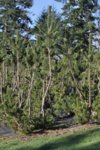Shohin is 8 inches or less from rim of pot to top of foliage.@Adair M ,
Sifu,
what you see me commenting on is what is happening.
So, at 4 years, in a 10 x 3 [ 2.5 inch ] deep container, the trees are hitting 1 inch.
If the tree then grows 2 more branches with that capacity, we will hit a 3 inch trunk.
A 3 inch trunk for us is a 15 to 18 inch tall tree.
That is normally as big as is grown down here because of the weight factor.
This year in a bigger pot, I will let you know visually how it went.
I am not sure 3 to 15/18 inches is shohin ?
Additionally the lower section, as you can see in the image above, is covered in
buds, so many choices.
Thus far no problems.
Adding on branchlets would begin x year later.
BY the way this is -------------------- Bonsai Today 12, page 19, and we are hybridisng
the comments on page 31.
We are checking the age - 5 years on page 26. and trunk size 3".
If we hit it, You have to River Dance. Okay
Thanks for responding.
Merry Christmas,
Anthony
* If you see no comments on Surface Roots, we got that on the first tree
naturally.
Last stages, branchlets and the elusive shortened needles.
Stayeth tuned.
And we are talking about JBP.



